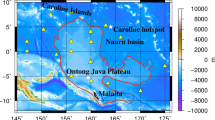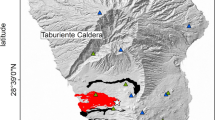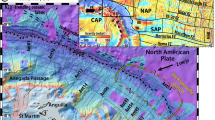Abstract
Earth’s largest earthquakes occur in subduction zones, along the boundary between the subducting and overriding plates1. Non-volcanic tremor generated by slow slip between the plates is thought to originate on, or near, this boundary2,3. Earthquakes also occur in the down-going plate as fluids are released4, and zones of anomalously low seismic velocities observed beneath several subduction zones are interpreted to be the subducting oceanic crust5,6,7,8,9,10. Yet, the exact location of the plate boundary remains uncertain5. Here we interpret a three-dimensional seismic tomography model from the northern Cascadia subduction zone in the northwest USA. We find that the low-velocity zone varies considerably along the Cascadia margin. In places, we observe the low-velocity zone to crop out at the surface and separate from the descending plate at depths of 35–40 km. We argue that the low-velocity zone here cannot represent oceanic crust as previously suggested, and instead the zone mostly represents sediments that have been subducted and underplated beneath the North American continent. We also find that tremor signals correlate with the position of the low-velocity zone, implying that slow slip and tremor may be facilitated by trapped fluids and high pore fluid pressures in subducted sedimentary rocks at, or close to the plate boundary. Our results also imply that the plate boundary beneath Cascadia is much deeper than previously thought.
This is a preview of subscription content, access via your institution
Access options
Subscribe to this journal
Receive 12 print issues and online access
$259.00 per year
only $21.58 per issue
Buy this article
- Purchase on Springer Link
- Instant access to full article PDF
Prices may be subject to local taxes which are calculated during checkout




Similar content being viewed by others
References
Pacheco, J. F., Sykes, L. R. & Scholz, C. H. Nature of seismic coupling along simple plate boundaries of the subduction type. J. Geophys. Res. 108, 14133–14159 (1993).
Obara, K. Nonvolcanic deep tremor associated with subduction in southwest Japan. Science 296, 1679–1681 (2002).
Rogers, G. & Dragert, H. Episodic tremor and slip on the Cascadia subduction zone: The chatter of silent slip. Science 300, 1942–1943 (2003).
Hacker, B. R., Peacock, S. M., Abers, G. A. & Holloway, S. D. Subduction factory 2. Are intermediate-depth earthquakes linked to metamorphic dehydration reactions? J. Geophys. Res. 108, 2030 (2003).
Nicholson, T., Bostock, M. G. & Cassidy, J. F. New constraints on subduction zone structure in northern Cascadia. Geophys. J. Int. 161, 849–859 (2005).
Kato, A. et al. Variations of fluid pressure within the subducting oceanic crust and slow earthquakes. Geophys. Res. Lett. 37, L14310 (2010).
Suckale, J. et al. High-resolution seismic imaging of the western Hellenic subduction zone using teleseismic scattered waves. Geophys. J. Int. 178, 775–791 (2009).
Yuan, X. et al. Subduction and collision processes in the central Andes constrained by converted seismic phases. Nature 408, 958–961 (2000).
Rondenay, S., Abers, G. A. & van Keken, P. E. Seismic imaging of subduction metamorphism. Geology 36, 275–278 (2008).
Rondenay, S., Bostock, M. G. & Shragge, J. Multiparameter two-dimensional inversion of scattered teleseismic body waves, 3, Application to the Cascadia 1993 data set. J. Geophys. Res. 106, 30795–30808 (2001).
Abers, G. A. et al. Imaging the source region of Cascadia tremor and intermediate-depth earthquakes. Geology 37, 1119–1122 (2009).
Miller, K. C. et al. Crustal structure along the west flank of the Cascades, Western Washington. J. Geophys. Res. 102, 17857–17873 (1997).
Parsons, T. et al. A new view into the Cascadia subduction zone and volcanic arc: Implications for earthquake hazards along the Washington margin. Geology 26, 199–202 (1998).
Brocher, T. M. et al. Wide-angle seismic recordings from the 1998 Seismic Hazards Investigation in Puget Sound (SHIPS), western Washington and British Columbia. US Geol. Surv. Open File Report 99–314, 1–129 (US Geological Survey, 1999).
Brocher, T. et al. Report for explosion data acquired in the 1999 Seismic Hazards Investigation in Puget Sound (SHIPS), Washington. US Geol. Surv. Open File Report 00-318, 1–85 (US Geological Survey, 2000).
Preston, L. A. Simultaneous Inversion of 3D Velocity Structure, Hypocenter Locations, and Reflector Geometry in Cascadia PhD thesis, Univ. Washington 1–112 (2003).
Preston, L. A., Creager, K. C., Crosson, R. S., Brocher, T. M. & Tréhu, A. M. Intraslab earthquakes: Dehydration of the Cascadia slab. Science 302, 1197–1200 (2003).
Nedimović, M. R., Hyndman, R. D., Ramachandran, K. & Spence, G. D. Reflection signature of seismic and aseismic slip on the northern Cascadia subduction interface. Nature 424, 416–420 (2003).
Brocher, T. M. et al. Upper crustal structure in Puget Lowland, Washington: Results from the 1998 Seismic Hazards Investigation in Puget Sound. J. Geophys. Res. 106, 13541–13564 (2001).
Brandon, M. T., Roden-Tice, M. K. & Garver, J. L. Late Cenozoic exhumation of the Cascadia accretionary wedge in the Olympic Mountains, northwest Washington State. Bull. Geol. Soc. Am. 110, 985–1009 (1998).
Calkins, J. A. et al. Shallow structure of the Cascadia subduction zone beneath western Washington from spectral ambient noise correlation. J. Geophys. Res. 116, B07302 (2011).
Van Wagoner, T. M., Crosson, R. S., Creager, K. C., Medema, G. & Preston, L. Crustal structure and relocated earthquakes in the Puget Lowland, Washington, from high resolution seismic tomography. J. Geophys. Res. 107, 2381 (2002).
Calvert, A. J. & Clowes, R. M. Deep, high-amplitude reflections from a major shear zone above the subducting Juan de Fuca plate. Geology 18, 1091–1094 (1990).
Hyndman, R. D. Dipping reflectors, electrically conductive zones and free water beneath a subduction zone. J. Geophys. Res. 93, 13391–13405 (1988).
Audet, P., Bostock, M. G., Christensen, N. I. & Peacock, S. M. Seismic evidence for overpressured subducted oceanic crust and megathrust fault sealing. Nature 457, 76–78 (2009).
Audet, P. et al. Slab morphology in the Cascadia fore arc and its relation to episodic tremor and slip. J. Geophys. Res. 115, B00A16 (2010).
Royle, G. T., Calvert, A. J. & Kao, H. Observations of non-volcanic tremor during the northern Cascadia slow-slip event in February 2002. Geophys. Res. Lett. 33, L18313 (2006).
Wech, A. G., Creager, K. C. & Melbourne, T. I. Seismic and geodetic constraints on Cascadia slow slip. J. Geophys. Res. 114, B10316 (2009).
La Rocca, M. et al. Cascadia tremor located near plate interface constrained by S minus P wave times. Science 323, 620–623 (2009).
Kao, H. & Shan, S-J. The source scanning algorithm: Mapping the distribution of sources in time and space. Geophys. J. Int. 157, 589–594 (2004).
Acknowledgements
We thank G. Abers for providing the geometry of the CAFE teleseismic profile and H. Kao for providing some tremor locations in Canada. This project was funded by the Natural Sciences and Engineering Research Council of Canada and US Geological Survey through grant 06HQGR0029. The acquisition of the various field data was supported by the US Geological Survey, the Geological Survey of Canada, the National Science Foundation, and several US and Canadian universities. Sandia National Laboratories is a multi-program laboratory managed and operated by Sandia Corporation, a wholly owned subsidiary of Lockheed Martin Company, for the U.S. Department of Energy’s National Nuclear Security Administration, under contract DE-AC04-94AL85000.
Author information
Authors and Affiliations
Contributions
L.A.P. created the tomographic velocity model and interpreted seismicity within the model; A.M.F. computed the tremor locations; A.J.C. interpreted velocity variations within the model and wrote the paper.
Corresponding author
Ethics declarations
Competing interests
The authors declare no competing financial interests.
Supplementary information
Supplementary Information
Supplementary Information (PDF 3496 kb)
Rights and permissions
About this article
Cite this article
Calvert, A., Preston, L. & Farahbod, A. Sedimentary underplating at the Cascadia mantle-wedge corner revealed by seismic imaging. Nature Geosci 4, 545–548 (2011). https://doi.org/10.1038/ngeo1195
Received:
Accepted:
Published:
Issue Date:
DOI: https://doi.org/10.1038/ngeo1195
This article is cited by
-
Fluid transport and storage in the Cascadia forearc influenced by overriding plate lithology
Nature Geoscience (2022)
-
Physical conditions and frictional properties in the source region of a slow-slip event
Nature Geoscience (2021)
-
Cascadia low frequency earthquakes at the base of an overpressured subduction shear zone
Nature Communications (2020)
-
Transient stripping of subducting slabs controls periodic forearc uplift
Nature Communications (2020)
-
Stress-driven fluid flow controls long-term megathrust strength and deep accretionary dynamics
Scientific Reports (2019)



